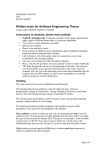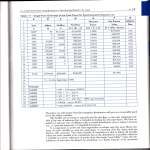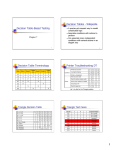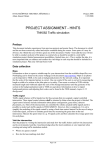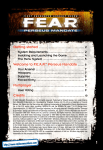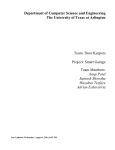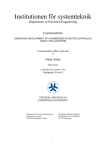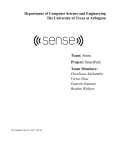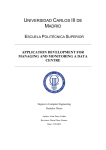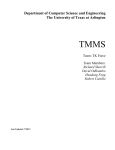Download Solutions
Transcript
LINKÖPINGS UNIVERSITET IDA David Broman, Kristian Sandahl Quiz Examination in Software Engineering Theory Solutions Date: 2007-09-20 Time: 11.20-12.00 The printed exam that was handed out at the lecture consisted of three different variants. All variants contained exactly the same questions, but the order of the statements was permutated, so that "accidental looking over the shoulder" could be avoided. This document describes the variant called (A). The variant indication of the exam can be found at the bottom of the page, right to the course code. Result Credits 9-18 0-8 Result Pass Fail The right answers for the different variants are as follows: Variant (A) Assignment 1 Answer B,D,E 2 B,C 3 B,D,E 4 A,D 5 D,E 6 A,D 7 A,E 8 C,E 2 B,E 3 A,C,F 4 C,D 5 B,C 6 B,D 7 C,E 8 B,D 2 D,E 3 B,E,F 4 B,C 5 A,E 6 B,E 7 A,E 8 A,E Variant (B) Assignment 1 Answer A,B,F Variant (C) Assignment 1 Answer C,D,E TDDC88-TDDC93 (A) Page 1(9) Problems Assignment 1. Project Management Figure 1 - A minimal project. Which of the following statements are true? □ (A) The critical path for the above project plan is RequirementsDesign-Implementation-Test. False. The critical path is Training-Implementation-Test. If the duration of the training activity is increased, the whole project will be delayed. □ (B) The slack time of the design phase is 2 working days. True. The duration of the design phase can be increased with 2 days without affecting the duration of the whole project. Note that only working days are counted. □ (C) Once you have defined the project plan, it is important that you follow it and do not change it during the life cycle. False. You definitely need to change and update the plan several times during a project, since you can do better planning when you get better understanding of the project. □ (D) COCOMO II is an algorithmic method for estimating efforts and Delphi is another effort estimation method based on expert judgements. True. □ (E) After that you have identified and analyzed risks, you should plan for how to handle them. One alternative is to transfer the risk. Another is to accept it and try to mitigate it. True. TDDC88-TDDC93 (A) Page 2(9) □ (F) When assigning roles to team members, it is important that one individual has only one role, e.g., to be designer, analyst or developer. False. It is very common that one team member can have several roles. Especially in small teams. Assignment 2. Architecture and Design Which of the following statements are true? □ (A) The main feature with box-and-line diagrams is that they are not ambiguous. False. One of the main problem with box-and-line diagrams is that they often are ambiguous. □ (B) Pipe and filter architecture styles are useful because they are easy to modify and can be implemented with concurrent execution. True. □ (C) Layered architecture styles are very common in data communication applications. True. □ (D) A repository model describes a system where databases are located on several distributed nodes and synchronization is performed if needed or on regular basis. False. The most important aspect of the repository model is that the data is centralized, not distributed. □ (E) The strategy pattern is useful when implementing a publish-subscribe system, e.g. when having different views of the same data. False. The strategy pattern is about encapsulating algorithms. What is described here is the observer pattern. TDDC88-TDDC93 (A) Page 3(9) Assignment 3. UML 1..4 +items Item mail : String getName() Group User Diagram 3 Diagram 1 engineers : Group mail = ”[email protected]” items anders : User mail = ”[email protected]” Diagram 2 Diagram 4 Which of the following statements are true? □ (A) Class User must implement operation getName(); False. Class item is abstract (italic font style), but the operation getName() is not abstract. Hence, getName() has an implementation in Item. Since the relation is generalization, class User inherits the implementation of getName() from class Item. Hence, class User do not need to implement getName(), even if it can overload it. □ (B) Class Item cannot be instantiated. True. Class Item is abstract and can therefore not be instantiated. □ (C) Diagram 2 is a valid object diagram of class diagram 1 and diagram 3 is not a valid object diagram of class diagram 1. False. Neither diagram 2, nor diagram 3 is valid. In diagram 3, an instance of class User contains other instances, which is not allowed according to the class diagram. Diagram 2 looks first correct, but note that the multiplicity for the composition relationship is 1..4. Hence, an instance of Group must hold at least one item. In diagram 2, the instance testers do not contain any items. Consequently, this object diagram is not a valid instance of the class diagram. TDDC88-TDDC93 (A) Page 4(9) □ (D) Diagram 4 is a valid object diagram of class diagram 1 and diagram 2 is not a valid object diagram of class diagram 1. True. Diagram 2 is not valid (see the answer above). Diagram 4 on the other hand is a valid object diagram of class diagram 1. □ (E) The composition relationship between Group and Item indicates ownership. True. This is the basic property of a composition relationship. □ (F) The property items is declared as private in the class diagram. False. The "+" symbol shows that items is public. If it would have been declared private, the symbol "-" would have been used. Assignment 4. Testing part I Which of the following statements are true? □ (A) Performance testing addresses non-functional requirements. One type of such a test is stress testing. True. □ (B) Failures in software can lead to faults when executing the system. False. It is the other way around. Faults in software can lead to failures when executing the system. □ (C) White-box testing is a useful technique, since information about the internal state of the system is not needed. False. White-box testing needs internal information about the system/module. What is described here is black-box testing. □ (D) If regression testing succeeds, it gives certain guarantees that the system works at least as good as at the last test occasion. True. TDDC88-TDDC93 (A) Page 5(9) Assignment 5. Testing part II Figure 2 - Graph with possible execution paths Cyclomatic complexity: V(G) = E - N + 2P Which of the following statements are true? □ (A) Cyclomatic complexity can be used to calculate the number of times a loop construct needs to be tested. False. Cyclomatic complexity gives the number of linear independent paths in a graph, which corresponds to the number of linear independent paths in program. It has nothing to do with how often a loop constructs needs to be tested. □ (B) The number of paths needed to cover the graph given in figure 2 is 4. False. The cyclomatic number for the above graph is 6. The total number of paths are more than 6. □ (C) The number of paths needed to cover the graph given in figure 2 is 5. False. (See above) □ (D) When implementing a bottom-up integration approach, you need to implement drivers. True. (For a top-down approach, stubs would have been needed instead.) □ (E) An oracle is a human being or a system that determines if a test is successful by examining the input and the generated output from a test object. True. TDDC88-TDDC93 (A) Page 6(9) Assignment 6. Requirements part I Which of the following statements are true? □ (A) The requirement “The user must be able to change his or her personal password” is a functional requirement. True. □ (B) The requirement “After 14 days of some usage, an average user must be able to run the system for at least 4 hours without using any help information, look up in the user manual or asking a colleague” is a functional requirement. False. This is a typical non-functional requirement. □ (C) The requirement “The user shall get response within a reasonable time” can be regarded as a good requirement, since a requirement about response time is hard to measure. False. It is definitely not a good requirement, since we want requirements to be measurable. Response time is not particularly hard to measure. □ (D) In an information system, a use case can describe several requirements and it is thus beneficial to start with use cases and then formulate detailed requirements afterwards, if needed. True. □ (E) It is important to vary the language (e.g. use synonyms) in a requirements specification so the readers will not become bored when reading the document. False. The specification should be as precise as possible, i.e., to be unambiguous. Varying the language by using synonyms gives the opposite effect. TDDC88-TDDC93 (A) Page 7(9) Assignment 7. Requirements part II Which of the following statements are true? □ (A) Specifying requirements with mathematical, formal notation increases clarity, i.e. the specification becomes less ambiguous. True. □ (B) Quality requirements are preferably specified with use-cases. False. Functional, not non-functional are captured using use-cases. □ (C) A beta-test is done internally amongst the developers before the acceptance test. False. During beta-testing, a version of the software is delivered to a limited audience outside the company. □ (D) Since it is generally hard for novices to grasp the idea of an entire system, it is a good strategy to wait with interviews of users and customers until only detailed questions of clarification remain. False. Users and customers should always be interviewed as early as possible, so that as correct requirements as possible are captured. □ (E) A heuristic evaluation during an afternoon with one or two user representatives will normally discover as much as 50% of all existing usability problems. True. TDDC88-TDDC93 (A) Page 8(9) Assignment 8. Quality Which of the following statements are true? □ (A) People think very differently about usability, so it is impossible to measure usability numerically. False. Even if people think differently, we can still do usability tests. We can measure things, such as time to perform a defined task, how many mistakes a test person makes etc. □ (B) A system with requirements of high reliability will preferably show a high failure intensity during acceptance testing. False. If reliability is very important in a product, we definitely do not want the system to fail a lot during the acceptance testing at the customer. □ (C) A hazard can lead to an incident, which in turn can become an accident. True. □ (D) The term Statistical Usage Testing, means that we use statistics when we describe test results. False. In statistical usage testing, the occurrences of the test cases correspond to the probability that certain functions of the system will be used. It has nothing to do with statistics about test results. □ (E) High portability of a system means that that the system can execute on several different platforms. True. TDDC88-TDDC93 (A) Page 9(9)









